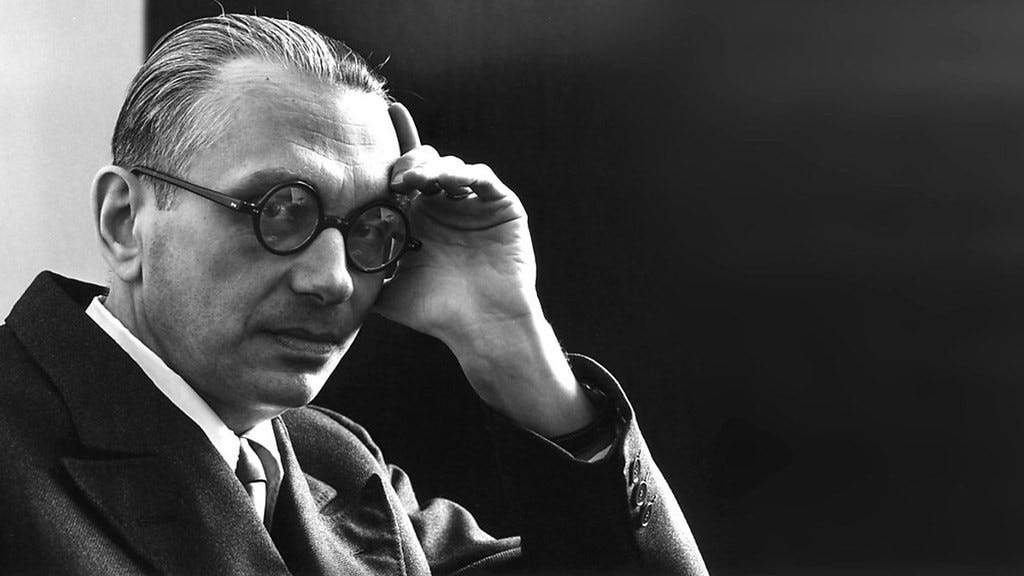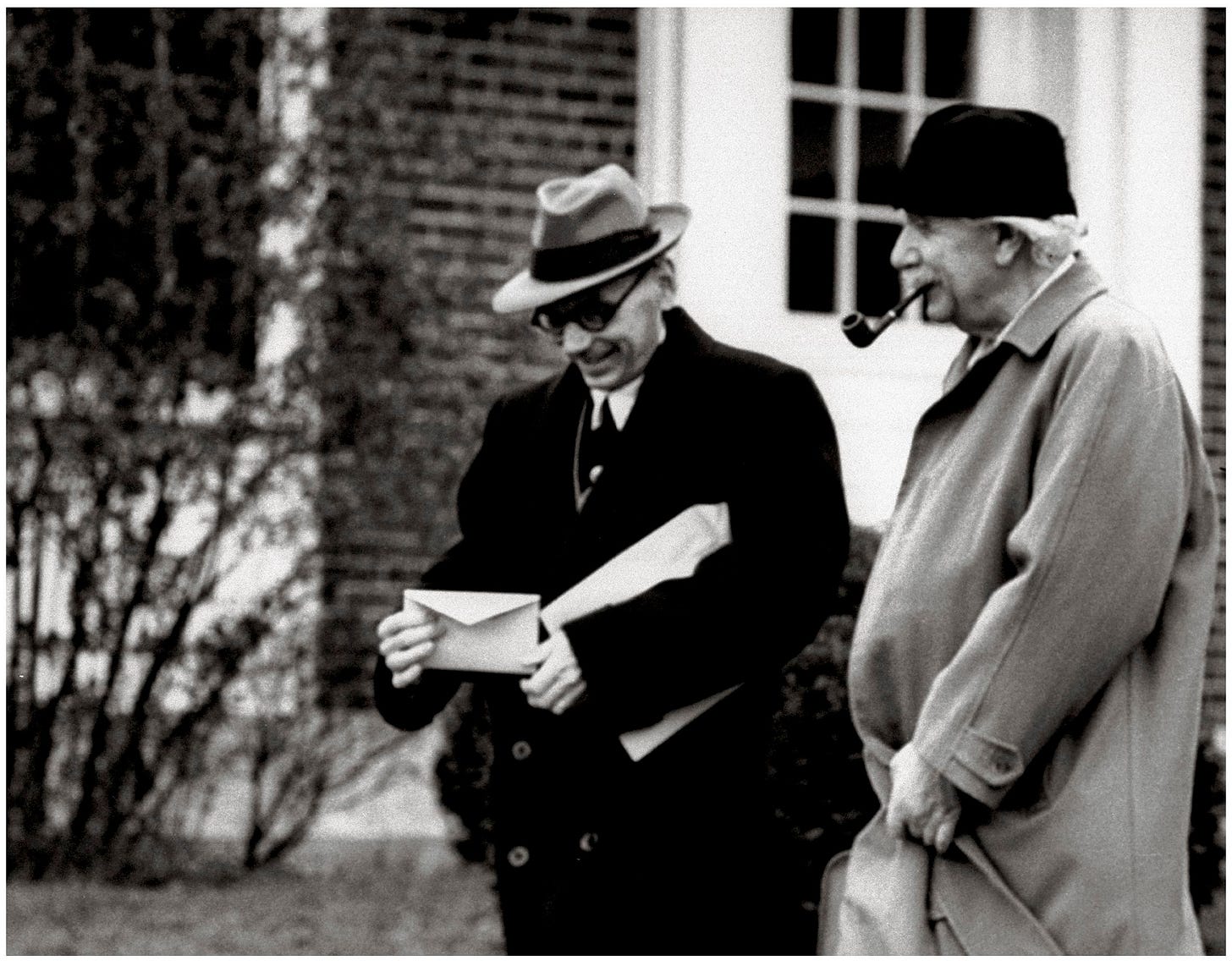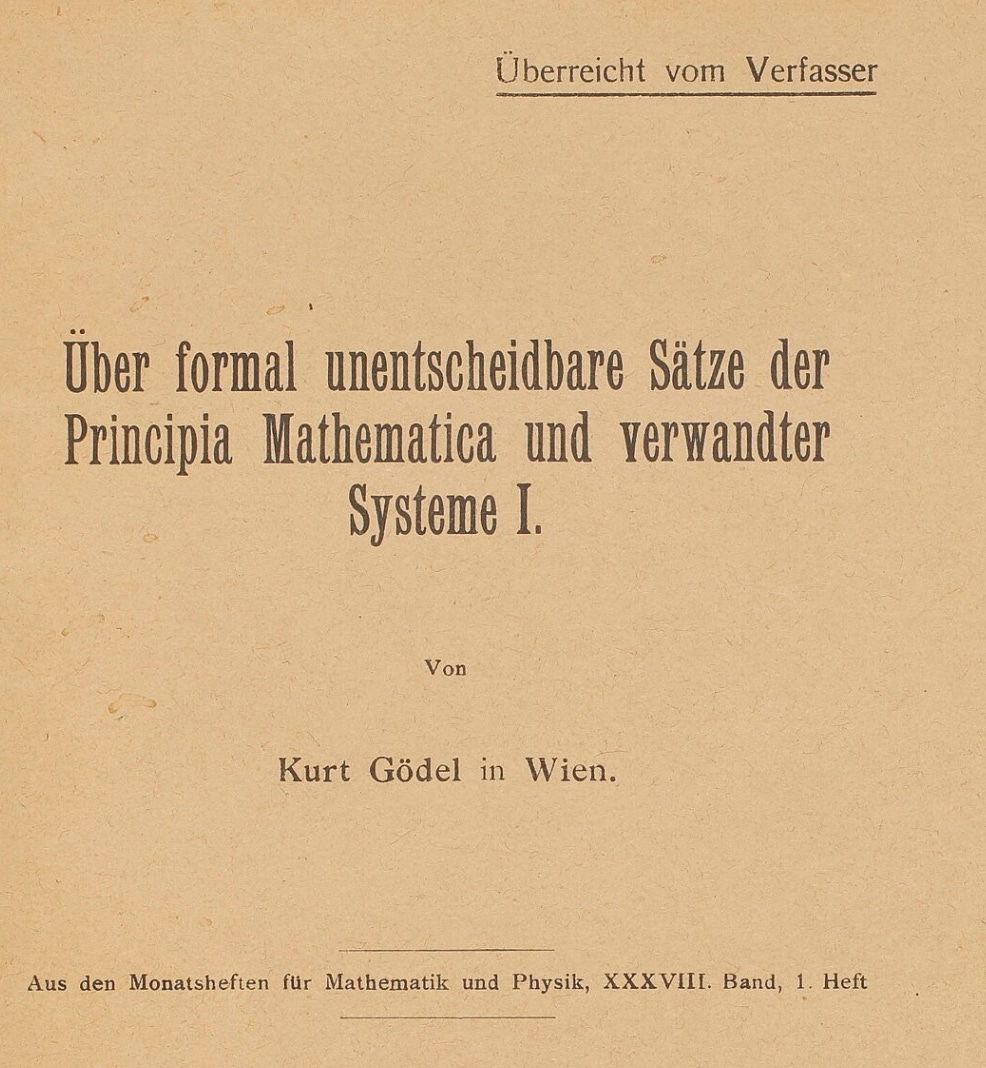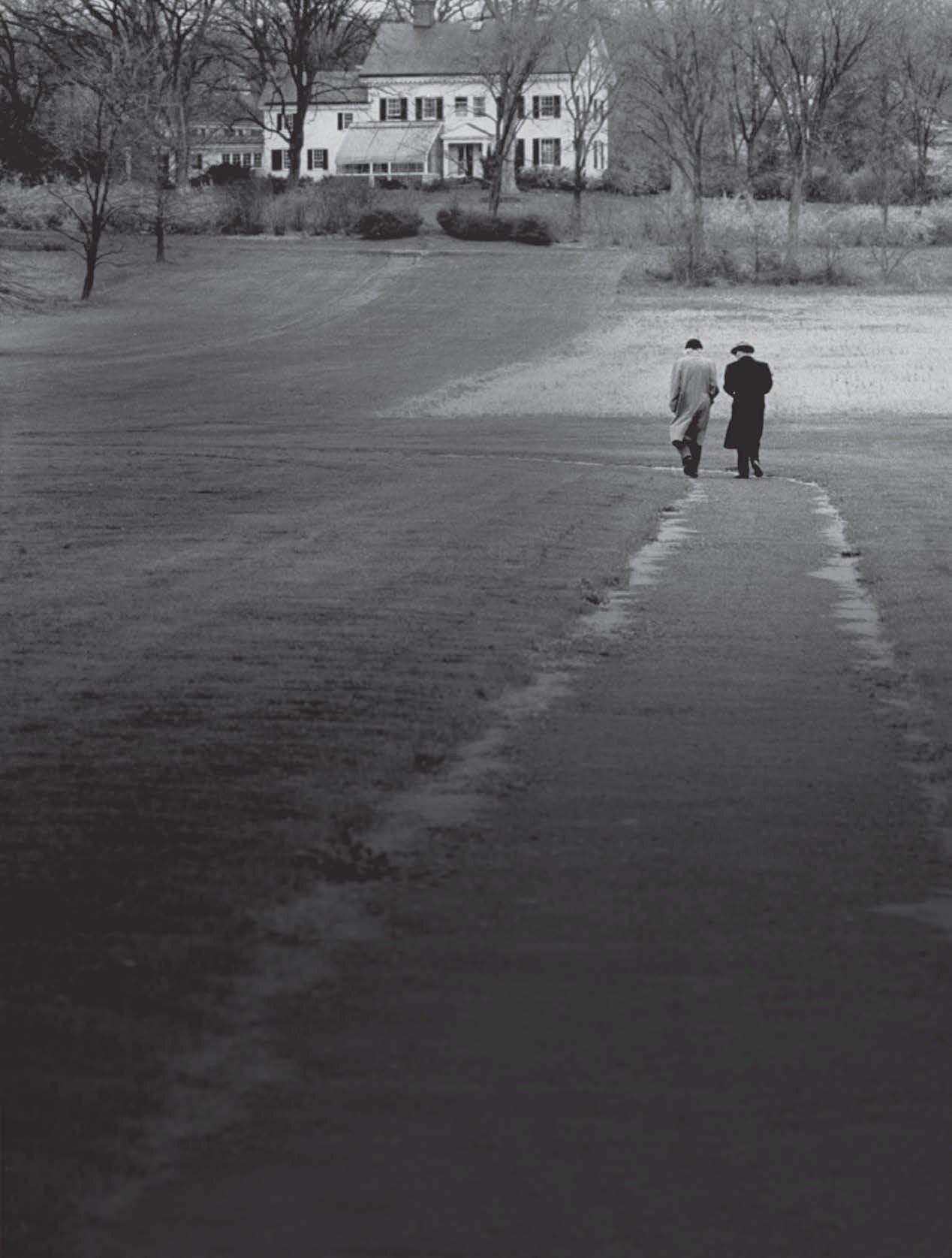The Incompleteness of Everything
Kurt Gödel and the Mathematics of the Unknown

Die Welt ist vernünftig / The World is Intelligible
— Kurt Gödel
I.
The scene is wintry Princeton, the late 1930s, a long stretch of road through a field. Two men are walking, residents of the esteemed Institute for Advanced Study, a special monastery for mathematicians, physicists, and other pure thinkers. They could be any two walkers, any two men, but even from a distance they would look strange, like two relics that had escaped from a museum.
A sketch may be drawn of the two, though it would necessarily remain incomplete. One of them is much older, defined by his fraying white hair and world-famous visage; the other man, a touch over thirty, is a recluse by nature and unknown beyond the gates of the Institute. They speak in German, the language of so many refugees and exiles, discussing what the elder Herr Doktor refers to as problems “of genuine importance.”
The first man, Albert Einstein, has gifted us with the mathematical laws of physical reality. The second man has proven a mathematical theorem so powerful, so consequential, so eerie, that its implications still haunt many years later.
His name was Kurt Gödel, and he was one of the twentieth century’s most important minds. Today, Gödel’s name is not as well-known as those of his contemporaries. His obscurity, however, is inversely related to his importance: If Einstein was the greatest physicist since Newton, Gödel can be considered the greatest logician since Aristotle. Indeed, Einstein paid his younger colleague the ultimate intellectual compliment, saying in his later years that he went to the Institute every day just to have the pleasure of walking home with Gödel.
Both Einstein and Gödel believed staunchly in the independence of mathematical reality from our minds. They were Platonists. Both were also introverts exiled from an Europe that had degenerated into racist hysteria. Gödel, though a gentile, looked Jewish enough that it hardly mattered: Nazi youths had once assaulted him in Vienna, breaking his glasses.
One difference between the two men was that while Einstein could get along with others when he needed, Gödel-the-eccentric might utter something so strange, so baffling, that people would be reduced to stupefied silence.
Precisely this had happened a decade prior, at a conference of leading mathematicians in the German city of Königsberg. Gödel was then a graduate student all of twenty-four-years-old. Many Old World mathematical eminences were present. At some point during the proceedings, the young Kurt Gödel off-handedly announced that he had come up with a proof for the incompleteness of arithmetic. The others couldn’t make sense of what they had just heard, but the Hungarian polymath John von Neumann—later inventor of game theory—intuited what was coming.
The next year, in 1931, Gödel published his paper. It was concise but vaunting. The title read: On Formally Undecidable Propositions of Principia Mathematica and Related Systems. His great proofs would come to be known as the Incompleteness Theorems, or simply, as Gödel’s theorem.
Roughly stated, the theorems show that in any logical system, there are truths which are undecidable and therefore cannot be proven or disproven. The second theorem, less relevant here, is that the consistency of a formal system cannot be proved within the system. There are levels to this, and even in strict mathematical terms, the proofs are considered formidable. Gödel invented his own numbering system, and was thus able to prove a theorem that also said something about the limits of all formal systems: It was not only a mathematical proof, but a meta-mathematical statement. A work of art and genius.
Here is how the Oxford mathematician Roger Penrose puts it:
According to the things that Gödel indisputably established was that no formal system of sound mathematical rules of proof can ever suffice, even in principle, to establish all the true propositions of ordinary arithmetic. This is certainly remarkable enough. But a powerful case can be made that his results showed something more than this, and established that human understanding and insight cannot be reduced to any set of rules.
The Incompleteness Theorems are chilling in their implications. The existence of truths that cannot be known. The fact that no system of rules can ever be both consistent and complete. The definite existence of indefinite propositions. A veil of permanent unknowability and uncertainty over all truth.
Over time, the theorems and the man would largely be obscured, curtained off from public view. There is something Gödel-like about that.
The wiry emigre from Vienna had drawn a question mark over the enterprise of mathematics. There were rumors that he was now attempting to come up with a mathematical proof for the existence of God.

II.
I had arrived at the work of Kurt Gödel through a circuitous route, from one book to another, and in hindsight, much like the lemma or intermediate stages of a proof, it seemed to build a grand conclusion that was just outside my grasp. In time, I was to fall in love with Gödel’s mind. There was no organic reason for this; his name, and his work, had been unfamiliar to me, until one December day, when I picked up a fateful novel.
The book that introduced the name of this Viennese mathematician was a work of fiction, a novel of ideas of the sort that is rarely published these days. In The Light of What We Know by Zia Haider Rahman not only mentions Gödel, but uses the incompleteness theorems as a kind of motif throughout the entire novel. Rahman is himself a mathematician born in Sylhet, in rural Bangladesh, and a graduate of Oxford and Yale. He is present both in the character of Zafar and in the unnamed narrator, who are united by Gödel’s theorems:
My suggestion to [Zafar], as we walked along a tree-lined street in Greenwich Village on that Sunday all those years ago, invited from him what seemed then the cryptic response that mathematics was full of beauty. I felt compelled to ask what he considered the most beautiful mathematics he had come across…Godel’s Incompleteness Theorem was his unhesitating answer, and though I remembered the statement of the theorem well enough, I nevertheless failed to perceive why he regarded it as particularly beautiful. Within any given system, there are claims which are true but which cannot be proven to be true.
So states the theorem. So simple. In its implications, it is a shocking theorem.
An exile, Zafar says at one point, is a refugee with a library. It’s a sentence that has been etched in my memory ever since, as has Kurt Gödel, whose name—the narrator tells us—Zafar pronounces inaccurately while a student at Oxford, but which he corrects when he is an adult, a reflection of Zafar’s migrations between social classes.
In The Light of What We Know is about more than Gödel—love, poverty, war, colonialism and what one could call the eternal or infinite ideas—but the great logician’s presence is indelible on every page. The lives of Zafar and Gödel mirror each other, and the Incompleteness Theorems are the invisible handiwork of the story, braided through the narrative the way Beethoven’s music courses through the novels of Thomas Mann.
Abstract, almost hidden, but certainly there, and intelligible to those who know where (and how) to look.
III.
Before going further into Gödel, some preliminaries must be considered. The mathematics discussed here are not the usual algebra, geometry, calculus that is tediously taught for too many years in school. Our school math is thousands of years old in most grades; this purer, higher mathematics is very different, and reaches the level of an art form, even if we non-mathematicians are led to believe it is not meant for us. Take it from me: I was a terrible math student, deserving of negative marks.
Reading about mathematics as a lay-person is a bewildering, frustrating experience. Few of us want to go back to that feeling of ignorance, being in the classroom, not understanding how the symbols and equations and numbers were related. This kind of ignorance is different from historical or literary ignorance, which can be sated with a few hours’ worth of reading. To the non-mathematical person, reading books about math is like poring over hieroglyphics. At times one feels like the man locked out of the asylum he was never admitted to, banging at the door to be let back in. Someone whose formal math education stopped at sixteen knocks on the door of the mathematical realm much the same, and usually receives no answer.
There is where my mind has been these last months. I have been immersed like a grade-schooler in this one subject that always troubled me, using Kurt Gödel as my north star. And the journey so far has not disappointed. School-math is to pure math what a prison is to a library. Pure mathematicians, in general, live in and among abstractions, not in what you or I would call “the real world”—even if their abstractions, ultimately, yield us everything that is necessary for our “real world” to exist, from advanced epidemiological models to cryptographic commerce to functional bridges.
Their mathematical work is done a priori—meaning it is based on pure reason and not subject to empirical revision. Once a mathematical theorem is proven, it is proven for all time.
At this level of abstraction mathematics becomes a creative art. No wonder Einstein said his work gave him such pleasure. Here is the verdict of G.H. Hardy, Cambridge mathematician and renowned twentieth-century thinker, whose memoir, A Mathematician’s Apology, is the most glorious of all books on the subject.
Hardy writes:
A mathematician, like a painter or poet, is a maker of patterns. If his patterns are more permanent than theirs, it is because they are made with ideas…The mathematician’s patterns, like the painter’s or poets, must be beautiful, must fit together in a harmonious way. Beauty is the first test: there is no permanent place in the world for ugly mathematics.
Later in the book, Hardy comments on how the beauty of mathematics is to be judged. “The ‘seriousness’ of a mathematical theorem lies, not in its practical consequences, which are usually negligible, but in the significance of the mathematical ideas which it connects.” In other words, the beauty of a mathematical idea is judged by how it is linked to other ideas, “in a natural and illuminating way.”
There is this fascinating mathematical conversation taking place across centuries that is accessible to us non-mathematical mortals. It is truly awe-inspiring to think that into this millennia-old conversation, an outsider can emerge and shake the entire system.
Such was the case with Gödel. It was also the case with Hardy’s most famous pupil, the child prodigy Srinivasa Ramanujan, who was born in India in the late-nineteenth century and who would go on to independently conceive mathematical proofs of stunning originality. Ramanujan was an impoverished clerk in Madras when he mailed some of his proofs to G.H. Hardy at Cambridge, who was initially irritated by the fan-mail. Hardy later noted that some of these proofs “defeated me completely; I had never seen anything in the least like them before.” Over his brief life, Ramanujan would independently compile over 3,000 mathematical works. He died of ill health at the age of 32.

Spend enough time in this abstract realm of beautiful math—which really begins to feel like spiritualism or mysticism at some point—and you observe a pattern. Mathematicians tend to go mad.
David Foster Wallace’s book, Everything and More: A Compact History of ∞ is probably the best book on mathematics by a non-mathematician, although it gets confusingly technical pretty quickly. Since the ancient Greeks, mathematics has always been thought of as related to questions of philosophy, existence, origins, and infinity. Since mathematical reality is conceived in the abstract—the child who asks “What does ‘5’ mean?” is really onto something—at some nth level of abstraction, one’s sanity can be jeopardized.
DFW quotes G.K. Chesterton:
Poets do not go mad; but chess players do. Mathematicians go mad, and cashiers: but creative artists very seldom. I am not attacking logic: I only say that this danger does lie in logic, not in imagination.
Of course, David Wallace’s own tragic end a few years later looms over the pages of this literary meditation on infinity. Knowledge at these extreme ends is an abyss more than a garden, and its curse—the curse of knowing—takes many victims, all of them tragedies.
DFW notes early on that those who have attempted to understand infinity often lost their minds. There is Georg Cantor, the book’s ostensible hero, who conceived of transfinite numbers and whose ideas about the hierarchy of infinities, initially ridiculed, were later widely accepted. Cantor claimed that God had revealed to him the concept of actual infinity; he died alone, in a mental hospital. There’s the aforementioned Ramanujan. Alan Turing ingested cyanide and died at age 41.
Then there is Kurt Gödel, who, paradoxically, was driven insane by his own rationality. Gödel strongly believed in what he called his “intuitions,” and believed that mathematical intuition was akin to sensory perceptions. He spent many years on his ontological proof for the existence of God, which argues that the Divine is the highest possible mental conception in our minds. Some would call this infinity. Cantor said his mathematical infinity was synonymous with God. Others disagree.
The questions are endless and irresolvable, and anyways, it seems the closer we get to the infinite, or that which lay beyond us, the more likely we are to be mentally defeated. A system cannot always be objectively understood from within, and dwelling on this level of abstraction, day after day, year after year, one risks flying too close to the sun.
IV.
Zafar led me to Gödel, whose work eventually led to the mathematician’s only true biographer: Rebecca Goldstein, a novelist and philosopher of science, who was a Ph.D. student at Princeton during Gödel’s last years. In her remarkable book, Incompleteness: The Proof and Paradox of Kurt Gödel, Goldstein brings a rare clarity to her subject and his beautiful mind.
Arriving in Princeton in the late 1970s, she recalls looking up the great mathematician’s name: “K. Goedel. It was like opening up the local phonebook and finding B. Spinoza or I. Newton.” The proof of Gödel and all its philosophical implications are discussed at length. It is the paradox that is truly mystifying.
Kurt Gödel was definitely weird, even by the extreme standards of mathematicians. At one point, Rebecca Goldstein mischievously sets out to visit Gödel’s house. This is a major intrusion—Gödel rarely has visitors, but curiosity wins the day. When she gets to his house, Goldstein is floored. There is a giant pink flamingo on the front yard.
I stared in disbelief at the bird. How could a man who had produced one of the most exquisite masterpieces of human thought have planted a pink flamingo on his front lawn?
At his U.S. citizenship ceremony, in 1947, accompanied by Einstein, Gödel told the presiding judge that he had discovered an internal contradiction in the U.S. Constitution that would allow a dictator to assume absolute power! All parties were perplexed, but quickly moved on. (According to Harvard Law Professor Laurence Tribe, the contradiction likely lay in Article V which deals with amendments to the Constitution.)
Gödel’s personal eccentricities only make him all the more endearing. They make his mind all the more electric, his theorems all the more enticing. There was more for him to achieve, but he was intensely reticent to publish anything. After Albert Einstein passed away, Gödel was deprived of his one true friend. He slowly unraveled.
Rebecca Goldstein notes that a paradox is when reason and rationality turn in on themselves, and there is an irresolvable contradiction. The system of logic collapses under the weight of its own rigor. Gödel believed that there were no accidents, that everything that happened had a cause that could be explained—The World is Intelligible, as he said. Yet his own logic would prove to be his undoing.
The eminent mathematician died in 1978, found in the fetal position. His exacting mind eventually came to believe that his refrigerator was poisoning him. His death certificate listed “malnutrition and inanition by personality disturbance” as the causes.
And yet, Gödel’s theorems, even now, live on. There is something indescribably gorgeous about Gödel, both the human being and the art he made. His Incompleteness Theorems continue to exist in that abstract realm where all mathematical reality resides, unseen, invisible, like music.
In Gödel’s model of the universe, time was cyclical and looped back on itself. There was no past, present, or future. The illusory nature of time feels more intuitive during a plague, when tomorrow is the same as yesterday. It is wondrous to think that in an alternative realm, Gödel and Einstein are still walking, still dreaming of infinite ideas.
But thinking must go on, especially during a plague. The pursuit of beauty and truth must go on, even in our suspended state of timelessness.
For now, reliving my boyhood days, it is mathematics I see everywhere: in the night sky, constellations visible from lifetimes ago, in a universe that is forever expanding, expanding at an accelerating rate, accelerating due to a mysterious force called dark energy—energy which can be neither seen nor detected. Thinking about the eternal mathematical truths represented in the language of numbers: in the composition of atoms, the movement of planets, the conservation of energy—energy that can be neither created nor destroyed, only altered in form.
Thinking about the infinite, about the uncertainties of our world, the curvature of a cloud, or the sheer mathematical improbability that either you or I or Einstein or Gödel would ever exist. It’s almost as if it were a miracle.



Absolutely amazing piece of intricately researched and well written article on Knowledge about the TRUTH that lies all around us, which we have all taken for granted and DO NOT have the TIME to ponder on this. Funny that the Plague u mention or the Pandemic of the 2020's has stalled the world and "Frozen Time" and its the ideal time to read such books by such great people of our times.
hi omer, this piece of writing is absolutely beautiful. "the pursuit of beauty and truth must go on, even in our suspended state of timelessness." love it. I learnt a lot about kurt godel. thank you. the piece uplifts me as one who failed maths completely and thoroughly in high school. no longer scarred from the experience because now am redeemed! good stuff.